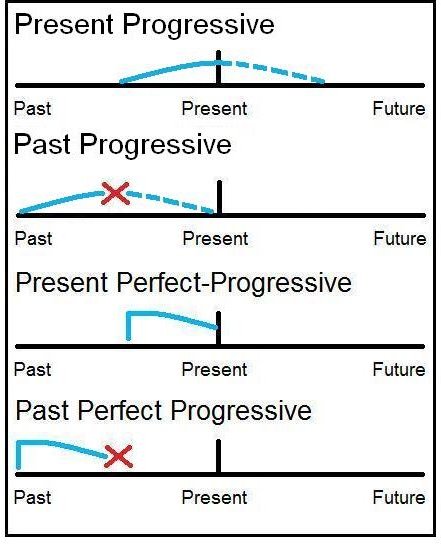How to Teach ESL Progressive Tenses
Grammatical Aspect
Although often referred to as a verb tense, the progressive is actually a grammatical aspect. Begin the ESL progressive tenses lesson
by providing a definition of aspect. First, explain that despite the continued misconception that there are anywhere between twelve and sixteen tenses in the English verb system, the English language has only nineteen conjugated verb forms that are combination of two tenses (present, past), four aspects (simple, progressive, perfect, perfect-progressive), three moods (indicative, subjunctive, imperative), and two voices (active, passive). Then provide the definition of grammatical aspect as the expression of the temporal structure of an action or state. If possible, use examples of aspect from the students’ first languages to clarify and exemplify the linguistic concept.
Progressive and Perfect-Progressive Aspects
Continue the ESL lesson by providing general definitions of the progressive and perfect-progressive aspects in English:
-
The progressive aspect expresses incomplete or ongoing actions or states at a specific time.
-
The perfect-progressive aspect expresses incomplete or ongoing actions or states that began in the past and continue into a specific time in the future.
Because verb aspect always occurs in combination with verb tense, next provide more detailed definitions of the progressive aspect and the perfect-progressive aspect that include grammatical tense:
-

The present progressive expresses an incomplete or ongoing action or state that began in the past, occurs in the present, and continues into the future, e.g., My mother is weeding the garden.
-
The past progressive expresses an incomplete or ongoing action or state that began, continued, and ended in the past but over a longer period of time than the completed actions expressed by the simple past tense, e.g., We were reading about Old English verbs.
-
The present perfect-progressive expresses and emphasizes the consequences resulting from a previous incomplete or ongoing action or state that began in the past and continues into the present but may or may not continue into the future, e.g., The child has been feeling ill.
-
The past perfect-progressive expresses and emphasizes the consequences resulting from a previous incomplete or ongoing action or state that began in the past and continues in the past until a specific time, e.g., The man had been stealing office supplies.
If possible, use examples of these four verb forms from the students’ first languages to solidify the concepts. For example, the progressive is a frequently used verb form in the Spanish language.
Forming the Progressive Aspects
After teaching definitions, explain how to form the four progressive aspects in English. Provide the following verb phrase patterns:
- present progressive → am/is/are + present participle
- past progressive → was/were + present participle
- present perfect-progressive → have/has + been + present participle
- past perfect-progressive → had + been + present participle
Next provide examples of the progressive aspects:
- The students are writing essays. (present progressive)
- He was throwing the ball. (past progressive)
- She has been working at the library for three years. (present perfect-progressive)
- The professor had been teaching for twenty-five years. (past perfect-progressive)
Progressive Aspect Activities
After teaching the ESL and EFL students the use and formation of the four progressive aspects, assign activities to practice these new verb forms. For example:
-
Conjugation practice: Provide students a list of verbs to conjugate into the four progressive forms, e.g., eat → am/is/are eating, was eating, have/has been eating, had been eating.
-
Writing practice: Provide students with lists of words to form into written sentences, e.g., her daughter / study (present progressive) / biology → Her daughter is studying biology.
-
Speaking practice: Ask students questions that must be answered with a verb in one of the four progressive aspects, e.g., What have you been learning? → I have been learning the progressive aspects.
ESL and EFL students must learn the four progressive aspects of verbs in order to fully understand and use the English language. This ESL progressive tenses lesson plan provides the necessary information and some suggested activities for teaching the present progressive, past progressive, present perfect-progressive, and past perfect-progressive to English language learners.
